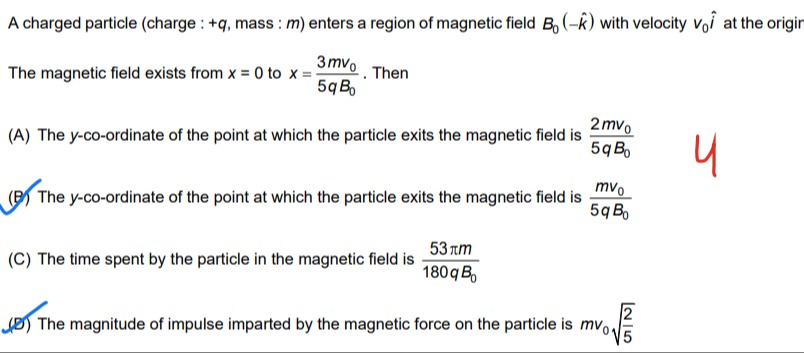Question
Question: A charged particle (charge: +q, mass: m) enters a region of magnetic field $B_0 (-\hat{k})$ with vel...
A charged particle (charge: +q, mass: m) enters a region of magnetic field B0(−k^) with velocity v0i^ at the origin.
The magnetic field exists from x = 0 to x=5qB03mv0. Then

The y-co-ordinate of the point at which the particle exits the magnetic field is 5qB02mv0
The y-co-ordinate of the point at which the particle exits the magnetic field is 5qB0mv0
The time spent by the particle in the magnetic field is 180qB053πm
The magnitude of impulse imparted by the magnetic force on the particle is mv052
B, D
Solution
The particle enters the magnetic field region (0≤x≤5qB03mv0) at the origin (0,0) with velocity v=v0i^. The magnetic field is B=−B0k^.
The magnetic force on the particle is F=q(v×B).
Initially, at the origin, F=q(v0i^×−B0k^)=−qv0B0(i^×k^)=−qv0B0(−j^)=qv0B0j^.
The force is perpendicular to the velocity, so the particle moves in a circular path in the x-y plane. The magnitude of the velocity remains constant, v=v0.
The radius of the circular path is R=qBmv=qB0mv0.
The initial velocity is in the +x direction, and the initial force is in the +y direction. This means the center of the circle must be located at a point (x_c, y_c) such that the radius vector from the center to the initial position (0,0) is opposite to the initial force direction. The initial force is in the +y direction, so the radius vector from the center to (0,0) must be in the -y direction. Thus, the center is at (0, R).
The equation of the circular path is x2+(y−R)2=R2.
The particle exits the magnetic field when its x-coordinate reaches xexit=5qB03mv0.
Let R=qB0mv0. The exit x-coordinate is xexit=53R.
To find the y-coordinate at the exit point, we substitute x=53R into the equation of the circle:
(53R)2+(yexit−R)2=R2
259R2+(yexit−R)2=R2
(yexit−R)2=R2−259R2=2516R2
yexit−R=±2516R2=±54R
yexit=R±54R
The two possible y-coordinates on the circle at x=53R are y1=R+54R=59R and y2=R−54R=51R.
The particle starts at (0,0) and the initial force is in the +y direction, so the particle moves into the region y>0. As the x-coordinate increases from 0, the y-coordinate initially increases.
The velocity components are vx=Rv0(R−y) and vy=Rv0x. Since x increases from 0 in the region, vy>0, confirming that y increases initially.
The particle path starts at (0,0) and moves towards increasing x and y.
The point (53R,59R) corresponds to an angle ϕ=arccos(−54)≈143.1∘ from the -y axis (using x=Rsinϕ,y=R−Rcosϕ).
The point (53R,51R) corresponds to an angle ϕ=arccos(54)≈36.9∘ from the -y axis.
The motion starts at ϕ=0 (at (0,0)). As x increases from 0 to 53R, the angle ϕ increases from 0. The y-coordinate is y=R(1−cosϕ). For 0≤ϕ≤π, 1−cosϕ increases from 0 to 2.
The x-coordinate is x=Rsinϕ. For 0≤ϕ≤π/2, x increases from 0 to R. For π/2≤ϕ≤π, x decreases from R to 0.
The particle exits at x=53R. This x-coordinate is reached at two possible angles ϕ1 and ϕ2 in the range [0,π], where sinϕ=53. These angles are ϕ1=arcsin(53) (in the first quadrant, ≈36.9∘) and ϕ2=π−arcsin(53) (in the second quadrant, ≈143.1∘).
The y-coordinate is y=R(1−cosϕ).
If sinϕ=53, then cosϕ=±1−(53)2=±54.
For ϕ1=arcsin(53), cosϕ1=+54. The y-coordinate is y1=R(1−54)=51R. This corresponds to the point (53R,51R).
For ϕ2=π−arcsin(53), cosϕ2=−54. The y-coordinate is y2=R(1−(−54))=59R. This corresponds to the point (53R,59R).
Since the particle starts at (0,0) and moves towards increasing x, the first time it reaches x=53R will be at the smaller angle ϕ1.
Thus, the y-coordinate at which the particle exits the magnetic field is yexit=51R=5qB0mv0.
Option (A) is incorrect. Option (B) is correct.
(C) The time spent by the particle in the magnetic field is the time taken to travel from the entry point (0,0) to the exit point (53R,51R).
The particle moves along the arc of the circle. The angle subtended by this arc at the center (0,R) is the change in the angle ϕ.
At the entry point (0,0), x=0,y=0. 0=Rsinϕentry, 0=R(1−cosϕentry). sinϕentry=0,cosϕentry=1. This corresponds to ϕentry=0.
At the exit point (53R,51R), x=53R,y=51R. 53R=Rsinϕexit, 51R=R(1−cosϕexit). sinϕexit=53, cosϕexit=1−51=54. This corresponds to an angle ϕexit=arcsin(53) (since sin>0,cos>0, it's in the first quadrant). Let α=arcsin(53). The angle is α.
The angle swept by the radius vector from the center is Δϕ=ϕexit−ϕentry=α−0=α.
The angular speed of the particle around the center is ω=Rv0=mv0/(qB0)v0=mqB0.
The time taken is t=ωΔϕ=qB0/mα=qB0mα.
Here α=arcsin(53). In radians, α≈0.6435 radians.
The time is t=qB0marcsin(3/5).
Let's check the value in option (C): 180qB053πm.
18053π radians corresponds to 53 degrees. arcsin(3/5)≈36.87∘.
So option (C) is incorrect.
(D) The impulse imparted by the magnetic force on the particle is J=∫Fdt=Δp=m(vexit−ventry).
ventry=v0i^.
At the exit point (53R,51R), the velocity vector is tangent to the circle. The velocity vector is perpendicular to the radius vector from the center (0,R) to the exit point (53R,51R).
The radius vector is (53R−0,51R−R)=(53R,−54R).
The velocity vector is proportional to (−(−54R),53R)=(54R,53R) or its negative.
The magnitude of the velocity is v0. So vexit=v0(54R)2+(53R)2(54R,53R)=v0R(54R,53R)=v0(54,53)=v0(54i^+53j^).
Let's check the direction of motion. The particle moves from (0,0) to (53R,51R). This is in the first quadrant. The velocity vector should have positive components. Our derived velocity vector has positive components, which is consistent.
vexit=54v0i^+53v0j^.
The impulse is J=m(vexit−ventry)=m((54v0i^+53v0j^)−v0i^)=m(−51v0i^+53v0j^).
The magnitude of the impulse is ∣J∣=mv0(−51)2+(53)2=mv0251+259=mv02510=mv052.
Option (D) states the magnitude is mv052. This is correct.
